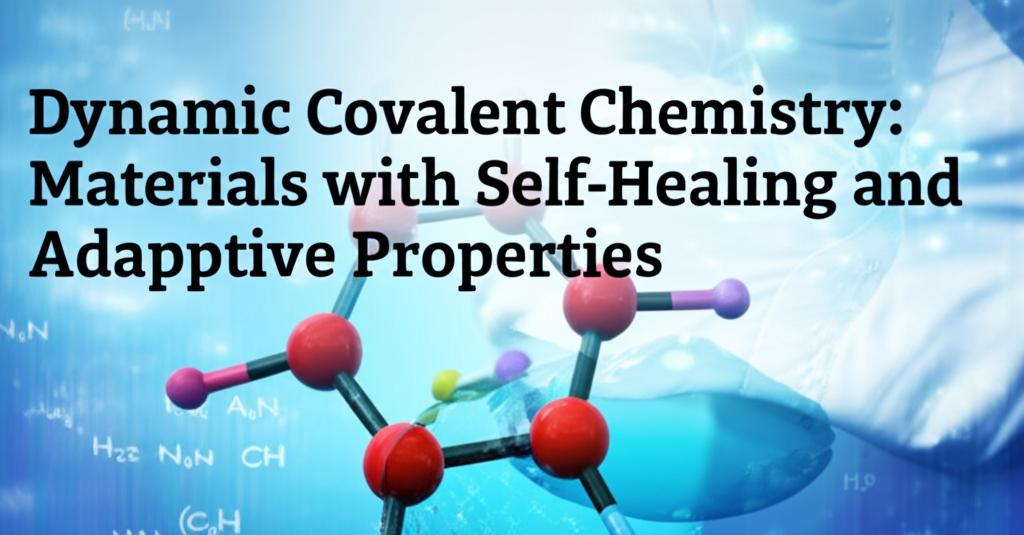Dynamic covalent chemistry (DCC) is a rapidly evolving field that harnesses reversible covalent bond formation to create intelligent materials. These materials exhibit remarkable properties such as self-healing, adaptability to external stimuli, and recyclability. This "living" characteristic allows them to respond to their environment, offering a new paradigm in materials science.
Core Principles: Reversible Bonds and AdaptabilityAt the heart of DCC are dynamic covalent bonds (DCBs). These bonds can break and reform, often in response to specific triggers like temperature, light, or pH changes. This reversibility allows the material's structure to rearrange, leading to its adaptive and healing capabilities. Common examples of DCBs used in these materials include:
- Imine bonds: Formed through a condensation reaction between an amine and an aldehyde or ketone, imine bonds are sensitive to pH and can be used to create self-healing hydrogels and other adaptive materials.
- Disulfide bonds: These bonds can undergo exchange reactions, enabling materials to be reprocessed and self-heal. They are often employed in creating recyclable polymers.
- Diels-Alder reactions: This cycloaddition reaction is thermally reversible, allowing for the creation of materials that can mend themselves upon heating.
- Boronic/boronate ester bonds: These bonds are responsive to changes in pH and the presence of diols, leading to applications in sensors and self-healing systems.
- Hindered urea bonds: These offer dynamic properties that can facilitate self-healing even at lower temperatures.
One of the most exciting applications of DCC is the development of self-healing materials. When a material containing DCBs is damaged (e.g., scratched or cracked), the reversible nature of these bonds allows them to reform across the damaged interface, restoring the material's structural integrity and, in some cases, its functionality. This process can be autonomous or triggered by an external stimulus like heat or light. For instance, polymers incorporating hindered urea bonds have demonstrated self-healing capabilities and even the restoration of electrical conductivity after damage.
Adaptive Properties: Responding to the EnvironmentBeyond self-healing, DCC allows for the creation of materials that can adapt their properties in response to environmental changes. This can manifest as:
- Shape memory: Materials can be programmed to remember an original shape and return to it when a specific stimulus (like temperature change) is applied. DCBs facilitate the reversible formation and dissociation of connections that enable this shape memory effect.
- Stimuli-responsiveness: Materials can change their characteristics, such as stiffness, permeability, or optical properties, in response to triggers like pH, light, or temperature. This opens doors for applications like smart sensors, drug delivery systems, and responsive coatings.
- Reprocessability and Recyclability: The dynamic nature of the bonds allows some of these materials to be reprocessed or broken down into their constituent monomers for recycling, contributing to a more circular economy for plastics and other polymers. Covalent adaptable networks (CANs) are a key example of this, offering a solution to the challenge of irreversible crosslinking in traditional thermosets.
The field of DCC is continually advancing, with recent progress focusing on:
- Enhanced Mechanical Properties and Healing Efficiency: Researchers are working to improve the balance between the dynamic nature required for healing and the robust mechanical properties needed for practical applications. Combining different types of dynamic bonds within a single material is one promising approach.
- Green Chemistry Principles: There is a growing emphasis on aligning DCC with green chemistry principles. This includes using bio-derived monomers to reduce reliance on petrochemicals and designing materials for closed-loop recycling.
- New Dynamic Chemistries: The discovery and implementation of new reversible reactions continue to expand the toolbox of DCC.
- Complex Architectures: DCC is enabling the synthesis of increasingly complex molecular architectures, including macrocycles, cages, and interlocked structures, which can lead to novel functionalities.
- Applications in Diverse Fields: The unique properties of DCC-based materials are being explored for a wide range of applications, from biomedical devices (like drug delivery systems and tissue engineering scaffolds) and soft robotics to advanced coatings and aerospace components. Recent research has explored using diselenide dynamic covalent bonds for shape-memory polymers that can transform from 2D sheets to 3D configurations via light programming.
Despite significant progress, challenges remain in optimizing bond exchange kinetics, scaling up production, ensuring long-term stability, and fully understanding the interplay between molecular design and macroscopic properties. However, dynamic covalent chemistry offers a powerful and versatile platform for creating the next generation of smart, sustainable, and high-performance materials. As our understanding of these systems deepens, we can expect even more sophisticated materials with tailored functionalities that can address critical societal needs.

